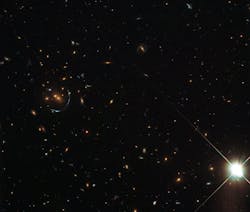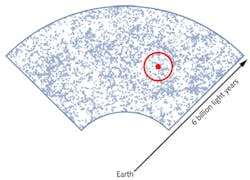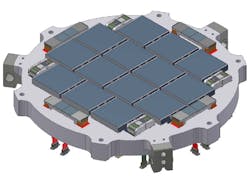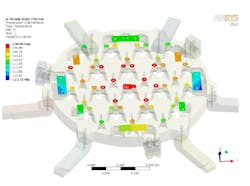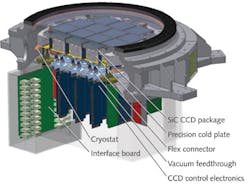PHOTONICS APPLIED: ASTRONOMY: Ground-based sky survey telescopes challenge large FPA technology
ALICE REINHEIMER
How do you measure the changing rate of expansion of the universe while standing on a mountain in Spain? The Javalambre Physics-of-the-Accelerating-Universe Astrophysical Survey (J-PAS) consortium (http://j-pas.org) has a plan that in large part depends on a sophisticated focal plane array being built by e2v.
The J-PAS project will measure the photometric red-shift of tens of millions of galaxies spanning more than 8000 square degrees of sky in order to better understand the large-scale structure of the universe, better known as Baryon acoustic oscillations. A 2.55 meter telescope has been built in Aragon, Spain, to house JPCam—a 14 CCD mosaic camera and 56 narrowband filter assembly that is presently under construction. The survey will provide what is essentially a low-resolution spectroscopic survey of the entire northern sky.
Baryon acoustic oscillations (BAO) refer to the regular, large-scale structures in the mass of the visible universe that are thought to be the remnant of acoustic density waves that formed in the plasma of the early universe.1 In the early millennia of the universe, the temperature and density was so high that matter could only exist as plasma, without atomic structure. Photons were trapped in the matter and could not travel far without being reabsorbed. Local dense spots that arose in the plasma resulted in a bubble of denser matter and trapped photons expanding around them-like a sound wave expands around an explosion (see Fig. 1).
When the universe was about 379,000 years old, it cooled to a temperature at which atomic hydrogen could form from individual electrons and protons. At this point, photons were released from the cooling plasma and could travel unimpeded, manifesting themselves as the well-known cosmic microwave background. This sudden transition left us with a snapshot of the plasma as it was when hydrogen "froze out." Surveys of the microwave background have shown that there is structure in its photon density, but only on a very small scale. However, when it comes to matter, this structure has been accentuated by the passage of time and the influence of gravity. Areas of higher density tend to attract matter while matter tends to leave areas of lower density. On a large scale, the matter in the universe has a frothy, bubbly structure—bubbles of "frozen" primordial plasma density waves or BAO (see Fig. 2).Measuring BAO structure
In the time since the universe cooled to the point where elemental hydrogen could form, it has continued to expand. In the late 1990s, observations of supernovas showed that this expansion has been continuing at an ever increasing rate. "Dark energy" is hypothesized as the cause of the accelerating expansion rate, and its nature has become one of the most important questions in cosmology today. Besides the supernova observations, measurements of the cosmic microwave background and the BAO can provide another yardstick for measurement of this expansion rate, helping cosmologists pin down the nature of dark energy (which some theories say comprises 68% of the total mass-energy of the universe). Fortunately, the BAO are of a fixed size and can provide us with a measurement of the rate of expansion, since closer "bubbles" will have expanded more than the younger ones further away.2
In order to measure the rate of expansion of the universe, J-PAS will precisely measure—over the course of five to six years—the redshifts, and therefore the positions, of more than 14 million early red-type galaxies as distant as 10 billion light years in 8000 square degrees of the northern sky.3 As Edmund Hubble famously announced in 1929, the degree to which a deep-space object's spectrum is shifted towards the red determines how far it is away from Earth.
To capture these redshifts, a new approach is being taken. Instead of measuring the angle across the "bubble" and its redshift to determine the distance to a BAO, J-PAS will measure through the BAO in a line of sight, precisely determining the redshifts of galaxies on either side. This allows a far more precise measurement of the dark energy parameter than previously thought possible.
Measuring redshifts with the needed precision requires that each galaxy be imaged through a set of 56 narrowband filters to produce a low-resolution spectrum of its spectral energy density.4 The narrowband filters span roughly 350–1000 nm, with the central bandpass widths being only 13.8 nm. The same section of sky will be imaged through all 56 filters to assemble the spectrum. However, since there are only 14 CCDs in the focal plane, the filters must be switched in and out, and multiple exposures must be taken of the same sky section.
The filters are designed to fit into four trays that are moved in and out above the focal-plane array (FPA) automatically, and each CCD is configured to image through just one of four filters. By dithering over the sky, enough images will be taken to produce a 56-layer-deep data cube of each section of sky. An extensive calibration will be needed to remove device-to-device variability and the variations caused by changes in sight conditions.5 Finally, redshift will be determined by fitting the 56-point red-type galactic spectra to simulated redshifted spectra of this well-known galactic type. It is estimated that this method can determine redshift values to a precision of 0.3%, as well as produce low-resolution spectra for hundreds of millions of other galaxies and deep-space objects.
The largest FPA
While e2v has long been known as a supplier of high-performance image sensors and FPAs, this will be the largest FPA we have supplied to date and our first foray into the supply of FPA support electronics (see Fig. 3). The sky will be imaged onto our 1.13 Gpixel camera with a 479 mm diameter FPA.6 The FPA consists of 14 (82 Mpixels each) CCD290-99 sensors mounted on a precision plate, cryogenically cooled, and flat to within 40 μm peak-to-valley over its entire area (compare this to the recently installed DECam FPA for the Dark Energy Survey with a diameter of 450 mm and a flatness specification of 60 μm peak-to-valley).Each CCD has 9216 × 9216 pixels with 10 μm pixel size, fully filling a 6 in. wafer. They are built on deep-depletion silicon for good red and near-infrared response, and are back-illuminated and coated with a multilayer antireflective coating for maximum sensitivity. Typically, their QE will exceed 90% over the 425–750 nm wavelength range, allowing a single broadband-optimized CCD to be used where previously the project would have had to choose between "red" and "blue" optimized versions.
There are 16 outputs per CCD, each with a two-electron read-noise floor and a "dummy" output to aid in common-mode noise removal. The CCDs are mounted on silicon carbide packages and are connected to the rest of the electronics using 150 mm flex circuit cables. Additional CCDs are mounted on the plate to provide wavefront sensing for adaptive-optics corrections and for auto guiding. The wavefront sensors image a star and measure the distortion caused by the atmosphere; this information is fed back to a deformable mirror that is dynamically offset to correct for the distortion.
A precision aluminum cold plate will keep the CCDs flat and cooled to their operating temperature, nominally -100°C. Despite the thermal expansion mismatch of silicon carbide and aluminum, the compliance built into the fixing points will allow for some movement between the dissimilar materials of the package and the plate. Thermal modeling and finite element analysis shows that controlling the thermal distribution of the plate will maintain its flatness at the operating temperature (see Fig. 4).Reading out a single CCD will produce almost 170 Mbytes of data.8 It is estimated that on a single observing night 1500 Gbytes of data will be produced for an estimated 1200 Tbytes of raw data over the course of the six-year survey (with an additional 30% to 50% more data for calibration frames). Essentially, it will take more than a day to process the data produced by a night's observation. When completed, the J-PAS survey will have produced high-resolution redshift values and low-resolution spectroscopy data using e2v's FPA for hundreds of millions of objects in the Northern sky and will have provided new insight into the nature of the increasing expansion of the universe.
REFERENCES
1. See http://bit.ly/12c9QfZ.
2. N. Benitez et al., Astrophys. J., 691, 1, 241–260 (2009).
3. K. Taylor et al., "JPCam: A 1.2Gpixel camera for the J-PAS survey"; see http://arxiv.org/abs/1301.4175.
4. A. Marín-Franch et al., "Design of the J-PAS and J-PLUS filter systems," Proc. SPIE, 8450 (September 2012).
5. N. Gruel, "Calibration plan for J-PAS and J-PLUS surveys," Proc. SPIE, 8448 (September 2012); see http://bit.ly/14NXeOV.
6. P. R. Jorden et al., "A Gigapixel commercially-manufactured cryogenic camera for the J-PAS 2.5m survey telescope," Proc. SPIE, 8453 (July 2012); see http://bit.ly/11Yj8Rj.
7. M. J. Clapp et al., "Development of a test system for the characterisation of DCDS CCD readout techniques," Proc. SPIE, 8453 (September 2012).
8. D. Cristóbal-Hornillos et al., "J-PAS data management pipeline and archiving," Proc. SPIE, 8451 (September 2012).
Alice Reinheimer is a senior applications engineer at e2v Aerospace and Defense, 765 Sycamore Drive, Milpitas, CA 95035; email: [email protected]; http://www.e2v.com/products-and-services/e2v-aerospace-and-defense/.
